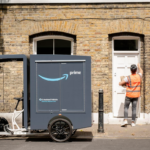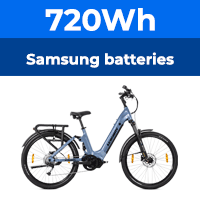Spare Cells
- Thread starter Marky T
- Start date
Wrapped in clingfilm and stored in the bottom of your fridge at the rear as near to zero degrees C as possible and preferably at around 20 to 40% charge, they will lose as little as 2% of capacity per year, and only 6% stored at full charge. Here's the relevant chart from the Battery University site:

.

.
Not accurately, the nominal voltage is 3.0 volts per cell and that's it's discharge rating as it reaches the end-of-ride emptiness. If your meter is a very high accuracy type you might get an indication from that.Cheers Flecc, is there anyway of telling the state of charge using a multimeter and could I boost the charge with a trickle charge?
Thanks Marky T
However, if you've received the cells new from the supplier, they will be close to half charge so ideal for immediate storage that way.
Trying to trickle charge could do more harm than good, so I'd avoid that.
.
It seems to me there might be a niche market for lithium charging units that can charge up a cell or pack of cells to 40% for storage.
The device would need to figure out the capacity through charging then fully discharging the cell/cells, then fully charge it again and discharge only 60% of the calculated capacity.
The device would need to figure out the capacity through charging then fully discharging the cell/cells, then fully charge it again and discharge only 60% of the calculated capacity.
Ok Flecc, the cells were out of a stripped down battery, so I will just check the voltage, to make sure that it's not really low, then store as you previously said. Thanks for your help, much appreciated.Not accurately, the nominal voltage is 3.0 volts per cell and that's it's discharge rating as it reaches the end-of-ride emptiness. If your meter is a very high accuracy type you might get an indication from that.
However, if you've received the cells new from the supplier, they will be close to half charge so ideal for immediate storage that way.
Trying to trickle charge could do more harm than good, so I'd avoid that.
.
Marky T
That's roughly right, but don't bother to store whole batteries or cells at very low temperatures for short periods between uses, there will be no gain and probably a loss of life due to the thermal and charging stresses of constantly reversing their state.Would I be right in guessing that a 36 volt battery (42 volts) will be 50% charged at 37 volts, and 40% charged at 36.5 volts?
Cold storage is a long term benefit only.
.
Some laptops do this for their batteries, my HP one enables me to drop the charge to any percentage I wish before cold storage which is for as long as a year at a time in my case. I'm beginning to forget how many years I've run the same lithium battery this way, and it still performs well in it's infrequent use.It seems to me there might be a niche market for lithium charging units that can charge up a cell or pack of cells to 40% for storage.
The device would need to figure out the capacity through charging then fully discharging the cell/cells, then fully charge it again and discharge only 60% of the calculated capacity.
.
That's interesting. I have three spare cells I purchased when I built my 36v pack almost 12 months ago.
I have kept mine at about 80-90% full charge at room temperature.
Never knew about the 40% charge and fridge storage
Regards
Jerry
I have kept mine at about 80-90% full charge at room temperature.
Never knew about the 40% charge and fridge storage
Regards
Jerry
Last edited:
I'd say not less than the usual two to three month recharge period for a battery that's not in cold storage. That of course prevents the self discharge damaging the battery.Ok Flecc knew that, but what is the minimum period you'll recommend to use that refrigeration method? A few months? And what about self-discharge, would it need topping up regularly?
I've never stored lithium e-bike batteries in this way. The ones I have use no BMS so don't self discharge at all. If doing it with an e-bike battery it would be best to allow a return to room temperature and recharge once every three months. I'd guess the self discharge could be slower at very low temperature due to cell efficiency reduction but I have no certainty of that.
I think the case for cold storage of whole BMS batteries isn't a strong one unless there is a facility for keeping a very consistent almost zero degrees. At the usual varying 5 to 10 degrees C of most household fridges it's probably not worth it since the gain would be trifling. As the chart shows, at 40% charge and between zero degrees and a hot room 25 degrees, there's only 2% difference in capacity loss, so between 5/10 degrees and UK ambient room temperatures would be perhaps 1%. Just leaving the battery outdoors in a garage would be good enough.
.
Errr. It was -4C last night. I was led to believe leaving it in the garage when the air temperature goes sub-zero was not such a good idea.Just leaving the battery outdoors in a garage would be good enough..
I doubt the temperature inside a cell casing, battery case and inside a garage would drop to anywhere near the outside temperatures though, due to the insulation effects of all three.Errr. It was -4C last night. I was led to believe leaving it in the garage when the air temperature goes sub-zero was not such a good idea.
In fact it's freezing the cell content rather than getting below zero degrees that could damage, and that couldn't occur without it being in a consistent -5 degrees C at the very least. We would probably need to smash some low temperature records for the outside temperature to be low enough to achieve that with in-garage storage.
.
50mm Celotex (available as seconds for half price) 12mm ply lining, Bob's Yerunkle.Single brick, no insulation and stood away from the house.....oh what I'd give for an insulated and heated one!
I sympathise, mine's similar but has garages on both sides so less overall direct exposure. I just store a car and some junk in there though.Single brick, no insulation and stood away from the house.....oh what I'd give for an insulated and heated one!
.
Related Articles
-
 MTF Enterprises announces acquisition of EMU Electric Bikes
MTF Enterprises announces acquisition of EMU Electric Bikes- Started by: Pedelecs
-
 Wisper 806T folding bike wins Which? ‘Best Buy’
Wisper 806T folding bike wins Which? ‘Best Buy’- Started by: Pedelecs
-
 Sustrans calls for protected cycle lanes
Sustrans calls for protected cycle lanes- Started by: Pedelecs
-
 Amazon launch their first UK e-cargo micromobility hub
Amazon launch their first UK e-cargo micromobility hub- Started by: Pedelecs



